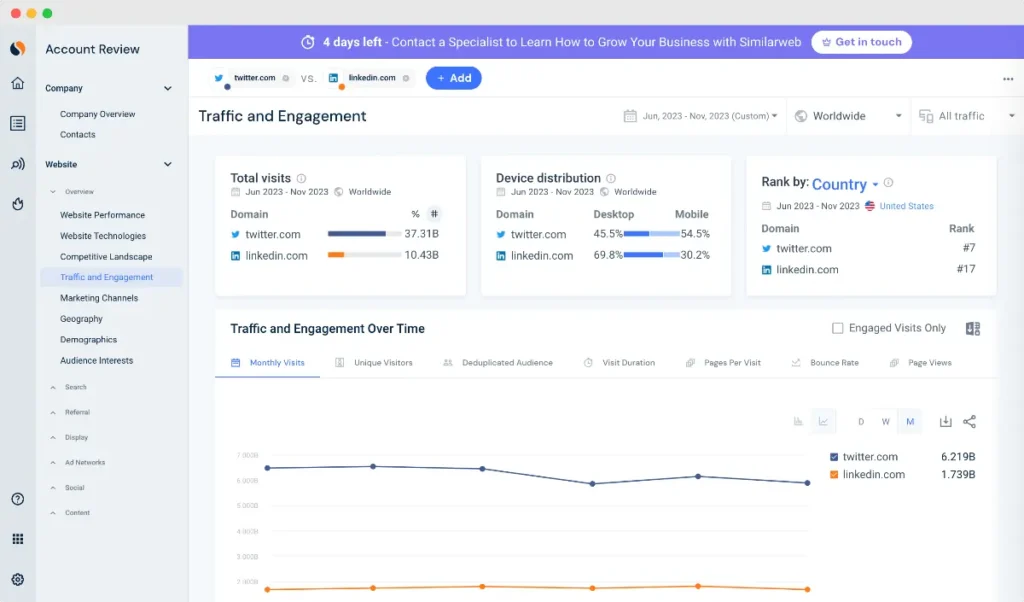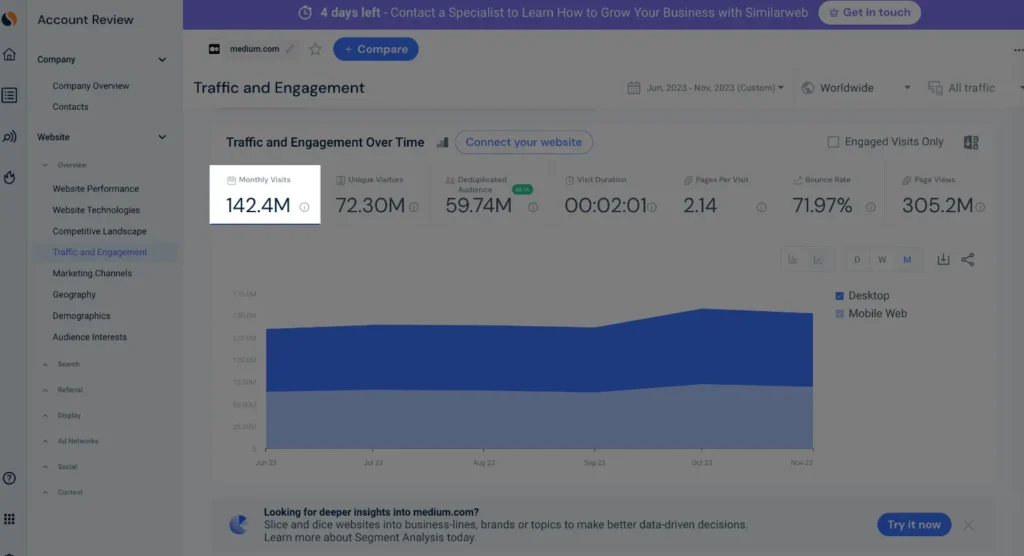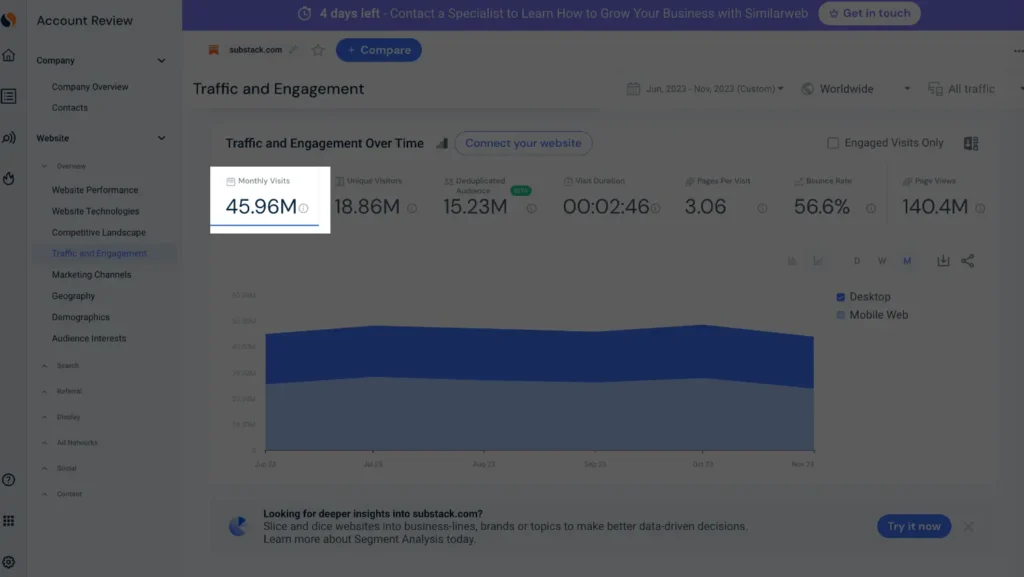So you want to start writing content on the Internet but don’t know whether you should go for blogging or social media?
You probably read contradictory advice and don’t really know which path is the best right now.
I’ve been creating content for over a decade using both blogs and social platforms.
So let me show you how to make the best choice so that you don’t waste 6 months of your life creating content in the void.
What Is Blogging?
When people talk about blogging, they are essentially referring to writing long-form articles of several hundreds of words each, and publishing them on a website (called a blog.)
Most people contrast blogging (long-form content) to writing on social media (short-form content).
While both are considered a form of blogging, what changes is mostly the length and how you can get traffic using both methods.
More on that later.
There are several different social media platforms out there.
So I’m going to focus this section on the platforms that make the most sense for writers.
If you’re reading this article, you’re likely interested in written social media platforms (that operate as “microblogs”.)
While video content is prevalent on platforms like Instagram and TikTok, written text still remains a cornerstone on social media platforms like X & LinkedIn (the most popular platforms for micro-blogging.)
According to SimilarWeb, X (formerly Twitter) is racking up 6 bn. visits a month, whereas LinkedIn 1.6 bn. a month.
Which both makes them the safest bet to start microblogging on social media:

After the 2024 US election, Bluesky started to get some traction. Their current user count is roughly 35 million.
Content on those platforms is relatively short (280-3,000 characters) and designed to grab attention and emotional interest.
Whereas content for blogging is primarily geared towards answering questions via SEO.
But you might also want to consider a hybrid option between blogging and social media.
Medium
Medium combines elements of a social media platform and a blogging platform.
What sets it apart is that it doesn’t require interaction with others to gain exposure. You also don’t need to learn SEO.
Well-written articles can gain traction and reach a broad audience.
On Medium, you can tap into a pool of 140 million visitors a month (data by SimilarWeb)

Success on Medium still hinges on other factors, such as crafting compelling headlines and introductions.
Substack
Another platform worth mentioning is Substack.
Substack similar to Medium but focuses more on getting email subscribers.
It’s definitely also considered a blogging platform and a new blogging alternative for creators who want to tap into an existing pool of readers.

Advantages of Blogging
There are several advantages to search traffic, making it a robust source of traffic for the past 25 years.
Unlike YouTube videos (where you have to re-record and upload a video from scratch to stay up to date), updating blog articles is easy and straightforward.
This ensures your content stays up-to-date over an extended period.
Blogs also benefit from the Lindy effect, meaning that non-perishable things have a longer shelf life the longer they are around. In contrast to betting on the latest social platform, blogs have a track record of success over the past 15 years and are likely to remain relevant in the future.
This stability is essential for leveraging your time without constantly creating new content to attract traffic to your products and services.
Maintenance & Technical Skills
Blogs are easy to maintain, once set up.
Most WordPress blogs get automated automatically so you really don’t have to think much about it.
Time to create content
For me, creating content on blogs is quicker and easier compared to other formats.
No matter blogging or social media, you need to dedicate at least 2 hours a day to it to get some traction.
It’s also possible to enhance your writing with AI writing tools since Google announced it will not penalize it. This makes creating long-form content faster and easier.
One of the traps of social media is that people think that because the content is short, it doesn’t take a long time to create.
However, this is not true.
Short-form content requires optimizing every microsecond to maintain audience attention.
Which means, more time in editing.
Your post hook is going to determine 80% of your success. So make sure to spend enough time on learning how to write good hooks.
I remember trying to craft a great social media post where it took me somewhere between 15 to 25 minutes just to get the hook right. In the same amount of time, I can easily create one or two blog posts.
Long-form content is more forgiving and easier to create than short-form content.
Content ownership
Moreover, when you publish on your blog, you have complete ownership of your content.
Even in the event of deplatforming from Google, you can always access your content on your blog.
This is in stark contrast to social media, where a ban from a platform results in the loss of your content. It blows my mind how many creators simply create and publish their work on social media platforms without keeping any backup of the content they invested hours of their life creating.
At the same time, those are missing opportunities to repurpose their content like in blog posts or emails as an example.
Benefits of Social Media
Social media requires no technical skills.
Setting up a social media profile, including:
- your profile
- banner image
- and writing a bio
can all be done in less than an hour.
In comparison, configuring a blog correctly may take several hours.
Social media allows you to easily connect with other influencers in your niche because it’s a social platform.
In contrast, if you want to contact and interact with other bloggers in your niche you probably have to go through a contact form or try to find their email, adding more friction to the process.
Social media also serves as a valuable tool for tracking (and jumping on) trends.
Trends drive significant attention. But you don’t necessarily need to create content on social media to benefit from them.
Tools like Google Trends, the trending feature on YouTube, or the trending feature on X can provide insights into what’s hot and effective in your market.
PRO TIP: Even though you want to start a blog, I would still recommend you create some social media profiles simply to be able to see what’s hot and what’s working in your market.
Where is it easier to attract an audience?
When you’re writing both on social media platforms and when blogging, you are at the mercy of algorithms.
When you engage in blogging, your primary focus is creating content for SEO (Search Engine Optimization) and ranking higher on Google.
This implies that you need to learn the basics of SEO. The good news is that I have a free course that shows you exactly how to do that. Simply click here to get started for free.
Social media algorithms are more geared towards engagement.
This is why you see a lot of shocking content or emotional content getting a lot of traction on social.
On Google, the type of blog posts that get the most actions are those that target at a specific keyword.
Longevity of traffic
What first got me started writing on the Internet is the fact that you can leverage your time effectively.
You can publish something on the Internet, and people are going to read the content for years to come.
One significant advantage of blogging is that well-crafted blog posts can continue to generate traffic for several years (when you know how to do it right).
For instance, I wrote blog posts back in 2014 that still rank today and consistently bring in traffic and clients for my business.
On the flip side, the shelf life of a social media post is really longer than a few minutes, and if you’re lucky, a few hours.
Which means that in order for your content to show up on other people’s newsfeed, you need to constantly crank out content.
There are different ways to repurpose your content though on those platforms; however, this is something that you need to keep in mind.
Challenges of Writing for Social Media
Writing for social media demands a different skill set. You must appeal to human emotions and work within specific character limitations.
For example, platforms like Twitter limit you to 280 characters, while LinkedIn allows up to 3000 characters. Managing line breaks and formatting is crucial.
Both blogging and social media require thorough market research, albeit for different purposes.
When crafting an SEO-focused blog post, conducting keyword research is essential to understand what people are searching for.
This knowledge is crucial for ranking effectively on Google’s algorithm.
On the other hand, social media content creation involves researching the problems, desires, and challenges people face within your niche.
It also requires you to interact with others, at least when you’re getting started because no one is going to check out your new street if you don’t have people engaging with your content already.
This is the major difference between blogging and social media.
This understanding helps you craft engaging posts that resonate with your audience.
So both require you to know your market.
Where is it better to make money
So the best way to make money as an expert and content creator with blogging or social media is by selling your own products (like online courses) and services.
So as an example, if you are creating your WordPress blog and publishing articles about your field of activities, what you want to do is build an email list and offer people to opt-in through your email list and then regularly follow up with emails and make them several offers related to what you have to offer. Social media is more or less the same thing, so what you’re going to do is invite people to opt into your email list and then do exactly the same thing in the backend:
Building a relationship and selling your own infoproducts.
So when you think about it, the mechanics of monetizing expertise are more or less the same. The only thing that changes is where you are going to get your traffic from.
Conclusion: Blogging Or Social Media?
If you enjoy engaging with others in your niche and seek more exposure through interactions, social media is the way to go.
On the other hand, if you’re an introvert like me and prefer not to interact extensively, blogging, whether on your own blog or on Medium or Substack, is the way to go.
Ironically enough, many social media gurus all end up setting up their own blog afterward to reap long-term traffic a blog offers.
No matter which option you choose, you still need to know and have valuable things to share with your audience.
Both ways take time to get discovered.
Don’t believe social media gurus who tell you that you can go viral in just 25 days. It’s the same thing for a blog.
Both methods work.
The only thing you have to ask yourself is, “What am I actually enjoying more?”
Because you need to be consistent to reap the rewards using any of those methods!
